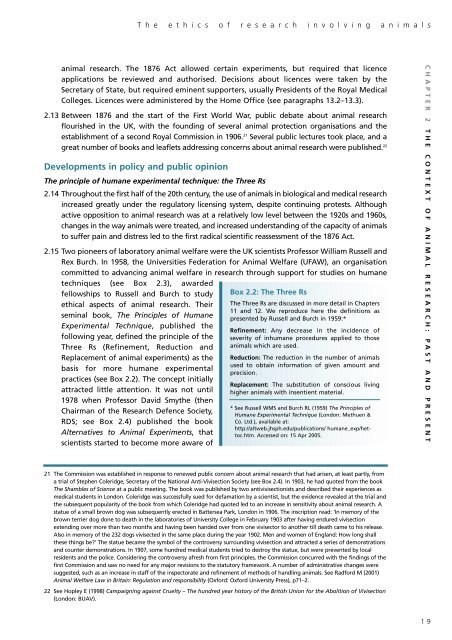The ethics of research involving animals - Nuffield Council on ...
The ethics of research involving animals - Nuffield Council on ...
The ethics of research involving animals - Nuffield Council on ...
Create successful ePaper yourself
Turn your PDF publications into a flip-book with our unique Google optimized e-Paper software.
T h e e t h i c s o f r e s e a r c h i n v o l v i n g a n i m a l s<br />
animal <str<strong>on</strong>g>research</str<strong>on</strong>g>. <str<strong>on</strong>g>The</str<strong>on</strong>g> 1876 Act allowed certain experiments, but required that licence<br />
applicati<strong>on</strong>s be reviewed and authorised. Decisi<strong>on</strong>s about licences were taken by the<br />
Secretary <str<strong>on</strong>g>of</str<strong>on</strong>g> State, but required eminent supporters, usually Presidents <str<strong>on</strong>g>of</str<strong>on</strong>g> the Royal Medical<br />
Colleges. Licences were administered by the Home Office (see paragraphs 13.2–13.3).<br />
2.13 Between 1876 and the start <str<strong>on</strong>g>of</str<strong>on</strong>g> the First World War, public debate about animal <str<strong>on</strong>g>research</str<strong>on</strong>g><br />
flourished in the UK, with the founding <str<strong>on</strong>g>of</str<strong>on</strong>g> several animal protecti<strong>on</strong> organisati<strong>on</strong>s and the<br />
establishment <str<strong>on</strong>g>of</str<strong>on</strong>g> a sec<strong>on</strong>d Royal Commissi<strong>on</strong> in 1906. 21 Several public lectures took place, and a<br />
great number <str<strong>on</strong>g>of</str<strong>on</strong>g> books and leaflets addressing c<strong>on</strong>cerns about animal <str<strong>on</strong>g>research</str<strong>on</strong>g> were published. 22<br />
Developments in policy and public opini<strong>on</strong><br />
<str<strong>on</strong>g>The</str<strong>on</strong>g> principle <str<strong>on</strong>g>of</str<strong>on</strong>g> humane experimental technique: the Three Rs<br />
2.14 Throughout the first half <str<strong>on</strong>g>of</str<strong>on</strong>g> the 20th century, the use <str<strong>on</strong>g>of</str<strong>on</strong>g> <str<strong>on</strong>g>animals</str<strong>on</strong>g> in biological and medical <str<strong>on</strong>g>research</str<strong>on</strong>g><br />
increased greatly under the regulatory licensing system, despite c<strong>on</strong>tinuing protests. Although<br />
active oppositi<strong>on</strong> to animal <str<strong>on</strong>g>research</str<strong>on</strong>g> was at a relatively low level between the 1920s and 1960s,<br />
changes in the way <str<strong>on</strong>g>animals</str<strong>on</strong>g> were treated, and increased understanding <str<strong>on</strong>g>of</str<strong>on</strong>g> the capacity <str<strong>on</strong>g>of</str<strong>on</strong>g> <str<strong>on</strong>g>animals</str<strong>on</strong>g><br />
to suffer pain and distress led to the first radical scientific reassessment <str<strong>on</strong>g>of</str<strong>on</strong>g> the 1876 Act.<br />
2.15 Two pi<strong>on</strong>eers <str<strong>on</strong>g>of</str<strong>on</strong>g> laboratory animal welfare were the UK scientists Pr<str<strong>on</strong>g>of</str<strong>on</strong>g>essor William Russell and<br />
Rex Burch. In 1958, the Universities Federati<strong>on</strong> for Animal Welfare (UFAW), an organisati<strong>on</strong><br />
committed to advancing animal welfare in <str<strong>on</strong>g>research</str<strong>on</strong>g> through support for studies <strong>on</strong> humane<br />
techniques (see Box 2.3), awarded<br />
fellowships to Russell and Burch to study<br />
ethical aspects <str<strong>on</strong>g>of</str<strong>on</strong>g> animal <str<strong>on</strong>g>research</str<strong>on</strong>g>. <str<strong>on</strong>g>The</str<strong>on</strong>g>ir<br />
seminal book, <str<strong>on</strong>g>The</str<strong>on</strong>g> Principles <str<strong>on</strong>g>of</str<strong>on</strong>g> Humane<br />
Experimental Technique, published the<br />
following year, defined the principle <str<strong>on</strong>g>of</str<strong>on</strong>g> the<br />
Three Rs (Refinement, Reducti<strong>on</strong> and<br />
Replacement <str<strong>on</strong>g>of</str<strong>on</strong>g> animal experiments) as the<br />
basis for more humane experimental<br />
practices (see Box 2.2). <str<strong>on</strong>g>The</str<strong>on</strong>g> c<strong>on</strong>cept initially<br />
attracted little attenti<strong>on</strong>. It was not until<br />
1978 when Pr<str<strong>on</strong>g>of</str<strong>on</strong>g>essor David Smythe (then<br />
Chairman <str<strong>on</strong>g>of</str<strong>on</strong>g> the Research Defence Society,<br />
RDS; see Box 2.4) published the book<br />
Alternatives to Animal Experiments, that<br />
scientists started to become more aware <str<strong>on</strong>g>of</str<strong>on</strong>g><br />
Box 2.2: <str<strong>on</strong>g>The</str<strong>on</strong>g> Three Rs<br />
<str<strong>on</strong>g>The</str<strong>on</strong>g> Three Rs are discussed in more detail in Chapters<br />
11 and 12. We reproduce here the definiti<strong>on</strong>s as<br />
presented by Russell and Burch in 1959:*<br />
Refinement: Any decrease in the incidence <str<strong>on</strong>g>of</str<strong>on</strong>g><br />
severity <str<strong>on</strong>g>of</str<strong>on</strong>g> inhumane procedures applied to those<br />
<str<strong>on</strong>g>animals</str<strong>on</strong>g> which are used.<br />
Reducti<strong>on</strong>: <str<strong>on</strong>g>The</str<strong>on</strong>g> reducti<strong>on</strong> in the number <str<strong>on</strong>g>of</str<strong>on</strong>g> <str<strong>on</strong>g>animals</str<strong>on</strong>g><br />
used to obtain informati<strong>on</strong> <str<strong>on</strong>g>of</str<strong>on</strong>g> given amount and<br />
precisi<strong>on</strong>.<br />
Replacement: <str<strong>on</strong>g>The</str<strong>on</strong>g> substituti<strong>on</strong> <str<strong>on</strong>g>of</str<strong>on</strong>g> c<strong>on</strong>scious living<br />
higher <str<strong>on</strong>g>animals</str<strong>on</strong>g> with insentient material.<br />
* See Russell WMS and Burch RL (1959) <str<strong>on</strong>g>The</str<strong>on</strong>g> Principles <str<strong>on</strong>g>of</str<strong>on</strong>g><br />
Humane Experimental Technique (L<strong>on</strong>d<strong>on</strong>: Methuen &<br />
Co. Ltd.), available at:<br />
http://altweb.jhsph.edu/publicati<strong>on</strong>s/ humane_exp/hettoc.htm.<br />
Accessed <strong>on</strong>: 15 Apr 2005.<br />
CHAPTER 2 THE CONTEXT OF ANIMAL RESEARCH: PAST AND PRESENT<br />
21 <str<strong>on</strong>g>The</str<strong>on</strong>g> Commissi<strong>on</strong> was established in resp<strong>on</strong>se to renewed public c<strong>on</strong>cern about animal <str<strong>on</strong>g>research</str<strong>on</strong>g> that had arisen, at least partly, from<br />
a trial <str<strong>on</strong>g>of</str<strong>on</strong>g> Stephen Coleridge, Secretary <str<strong>on</strong>g>of</str<strong>on</strong>g> the Nati<strong>on</strong>al Anti-Vivisecti<strong>on</strong> Society (see Box 2.4). In 1903, he had quoted from the book<br />
<str<strong>on</strong>g>The</str<strong>on</strong>g> Shambles <str<strong>on</strong>g>of</str<strong>on</strong>g> Science at a public meeting. <str<strong>on</strong>g>The</str<strong>on</strong>g> book was published by two antivivisecti<strong>on</strong>ists and described their experiences as<br />
medical students in L<strong>on</strong>d<strong>on</strong>. Coleridge was successfully sued for defamati<strong>on</strong> by a scientist, but the evidence revealed at the trial and<br />
the subsequent popularity <str<strong>on</strong>g>of</str<strong>on</strong>g> the book from which Coleridge had quoted led to an increase in sensitivity about animal <str<strong>on</strong>g>research</str<strong>on</strong>g>. A<br />
statue <str<strong>on</strong>g>of</str<strong>on</strong>g> a small brown dog was subsequently erected in Battersea Park, L<strong>on</strong>d<strong>on</strong> in 1906. <str<strong>on</strong>g>The</str<strong>on</strong>g> inscripti<strong>on</strong> read: ‘In memory <str<strong>on</strong>g>of</str<strong>on</strong>g> the<br />
brown terrier dog d<strong>on</strong>e to death in the laboratories <str<strong>on</strong>g>of</str<strong>on</strong>g> University College in February 1903 after having endured vivisecti<strong>on</strong><br />
extending over more than two m<strong>on</strong>ths and having been handed over from <strong>on</strong>e vivisector to another till death came to his release.<br />
Also in memory <str<strong>on</strong>g>of</str<strong>on</strong>g> the 232 dogs vivisected in the same place during the year 1902. Men and women <str<strong>on</strong>g>of</str<strong>on</strong>g> England: How l<strong>on</strong>g shall<br />
these things be?’ <str<strong>on</strong>g>The</str<strong>on</strong>g> statue became the symbol <str<strong>on</strong>g>of</str<strong>on</strong>g> the c<strong>on</strong>troversy surrounding vivisecti<strong>on</strong> and attracted a series <str<strong>on</strong>g>of</str<strong>on</strong>g> dem<strong>on</strong>strati<strong>on</strong>s<br />
and counter dem<strong>on</strong>strati<strong>on</strong>s. In 1907, some hundred medical students tried to destroy the statue, but were prevented by local<br />
residents and the police. C<strong>on</strong>sidering the c<strong>on</strong>troversy afresh from first principles, the Commissi<strong>on</strong> c<strong>on</strong>curred with the findings <str<strong>on</strong>g>of</str<strong>on</strong>g> the<br />
first Commissi<strong>on</strong> and saw no need for any major revisi<strong>on</strong>s to the statutory framework. A number <str<strong>on</strong>g>of</str<strong>on</strong>g> administrative changes were<br />
suggested, such as an increase in staff <str<strong>on</strong>g>of</str<strong>on</strong>g> the inspectorate and refinement <str<strong>on</strong>g>of</str<strong>on</strong>g> methods <str<strong>on</strong>g>of</str<strong>on</strong>g> handling <str<strong>on</strong>g>animals</str<strong>on</strong>g>. See Radford M (2001)<br />
Animal Welfare Law in Britain: Regulati<strong>on</strong> and resp<strong>on</strong>sibility (Oxford: Oxford University Press), p71–2.<br />
22 See Hopley E (1998) Campaigning against Cruelty – <str<strong>on</strong>g>The</str<strong>on</strong>g> hundred year history <str<strong>on</strong>g>of</str<strong>on</strong>g> the British Uni<strong>on</strong> for the Aboliti<strong>on</strong> <str<strong>on</strong>g>of</str<strong>on</strong>g> Vivisecti<strong>on</strong><br />
(L<strong>on</strong>d<strong>on</strong>: BUAV).<br />
19
















